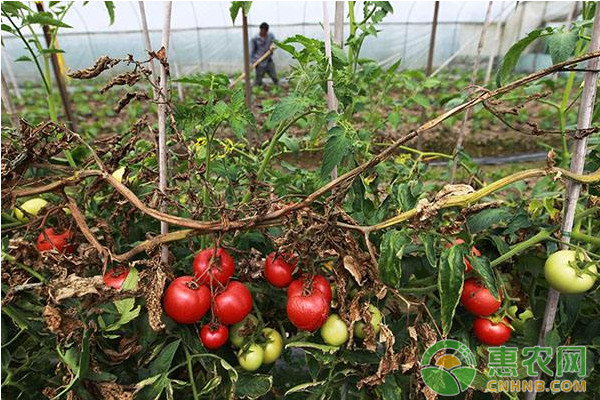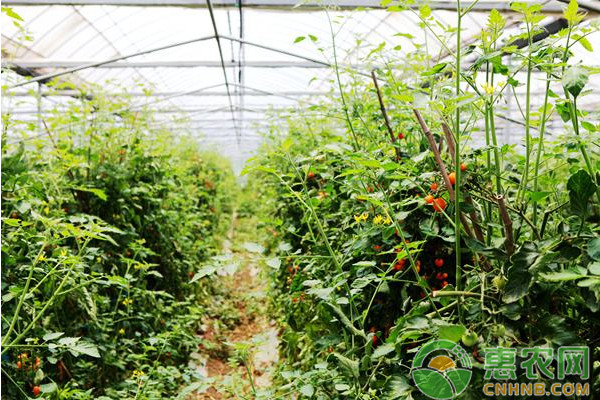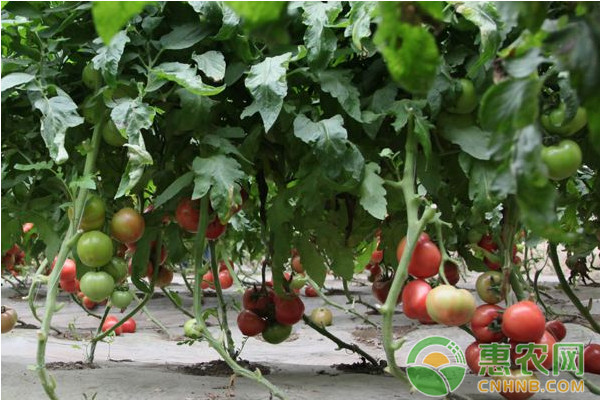Now more and more developed China's agricultural technology, cultivation techniques through late autumn accumulated years of experience and development has become more perfect, bringing it below the greenhouse tomato late autumn cultivation techniques for everyone.

Tomato seedlings in late autumn general in early June to mid-July, September-November harvest. Hot and rainy early growth stage, serious pests and diseases, post-temperature gradually decreased, need cold insulation, prevent damage, its high technology content, if the incorrect cultivation and management techniques, it is difficult to achieve the expected benefits.
1 seedling preparation
1.1 Seedbed selection
The seedbed must be selected in a plot that has not been planted with solanaceous vegetables and has a ventilated sun, high terrain, good drainage, and abundant soil organic matter.
1.2 Seedbed production
The seedbed is best to choose north-south direction, generally 1.5m wide and the surface is 0.25m above the ground. The length can be customized according to the requirements. The seedbed area is 25~30m2 per 667m2.
1.3 nutrient soil preparation
The fermented fermented pig manure and the sieved fine soil were prepared at a ratio of 1:10, and 10 kg of phosphate fertilizer and 3 kg of diammonium phosphate were added per m3 of nutrient soil, but urea could not be applied. Add 40 g of pentachloronitrobenzene powder 100 g or 50% carbendazim WP 100 g and 80% trichlorfon powder 100 g per m3 of soil, then mix well.
2 sowing seedlings
2.1 Variety selection
Generally, large fruit varieties with strong disease resistance, high yield, heat resistance and infinite growth are selected, such as Jiafen No.1, Zhengfan No.2, Tropic, and Xiyou Ruyi.
2.2 Sowing time
The suitable sowing time for tomatoes in the autumn is from mid-June to early July. Seeding is too early, the seedling temperature is high, and the pests and diseases are serious; the sowing is too late, the temperature is low in the late stage, the growth period is short, and the yield is low.
2.3 Seeding rate
In line with the principle of using strong seedlings and abandoning weak seedlings, generally 15 to 20 g of tomato seeds are needed per 667 m2 of shed.
2.4 Seedling methods
Put the prepared nutritious soil into the nutrient bowl and place it on the surface of the cake. The nutrient soil is slightly compacted, and 3,000 nutrient pieces per 667 m2 are needed. Generally, there is no seed for germination. After 4 to 5 days, the seedlings are released. During this period, the nutrient soil should be kept moist. When the nutrient soil is dry, it should be wetted with watering can on sunny or morning, and it should not be watered, and the seedlings will grow to a true leaf. When spraying with 800 times of 72.2% Plex water solution; 2~3 pieces of true leaves, spray once with 20% virus A wettable powder 500 times solution or 1.5% phytopathogenic emulsion 600 times solution;

When 3 to 4 true leaves are sprayed, spray 25% of the water (10 mL each), 2 pieces of water per barrel (20 mL); 4 to 5 pieces of true leaves, spray 50% of the speed Wet powder 800 times liquid or 50% chlorhexidine WP 600 times solution; 3 days before planting, spray 50% chlorothalonil WP 600 times solution and 25% auxil water agent (20 mL per barrel of water) In case of prevention. When planting, the shed cannot be completely shaded with a shade net. As the seedling grows, it is necessary to gradually receive strong light. Starting from the seedlings to 4 true leaves, cover the sunshade from 9:00 am to 5:00 pm during the day, 5 pm After the removal of the shading net refining seedlings, 2 to 3 days before planting, all the shading nets were removed to see the light, to adapt to the greenhouse.
3 Preparation before planting
3.1 Site preparation
Deeply fertilize before planting, thoroughly clean the stems and roots of the former crops, especially the residual leaves that fall on the ground to prevent the spread of germs. Apply sufficient base fertilizer, apply 4~6kg of high-quality soil fertilizer, 100kg of phosphate fertilizer, 50kg of potassium sulfate compound fertilizer and 50kg of diammonium phosphate per 667 m2. As a result, the large row spacing is 0.9m, the small row spacing is 0.5m, and the plant spacing is 0.4m.
3.2 Timely colonization
About 25d after sowing, the seedling height is 0.2m, and 5 leaves of true leaves are suitable for seedling age. After the autumn extension, the tomato requires early planting, small seedlings are planted, and the flower buds are not seen when planting, and the shed film is buckled before planting. About 2,500 plants are planted per 667 m2, and the shed film is shaded by a sunshade net when planted.
Post-plant management
4.1 Watering
When planting, pour a large amount of water, and after 5 to 7 days, pour a slow water. When the temperature is high, the amount of air should be increased. When there is no rain, the bottom wind and the upper wind should be opened to the maximum to facilitate cooling, and 35% should be sprayed once. A cream · Fumei double wettable powder 600 times liquid + 72% agricultural streptomycin sulfate wettable powder 3 000 times liquid, sprayed once every 5 ~ 7d 20% virus A wettable powder 500 times liquid to prevent viral diseases. In case of high temperature, water can be cooled in a large row.
4.2 Chemical regulation
During the growth of the tomato, in order to prevent the lengthening, it is possible to spray 15 kg of water with 15 mL of 25% auxin.
4.3 Pruning
After the autumn extension, the tomato generally leaves 6 to 7 ears, and the first ear leaves 3 to 4 fruits, and 4 to 5 fruits are left for each ear. In order to prevent the phenomenon that the tomato is difficult to sit at high temperature after the autumn extension, it should be changed. The method of pruning the head, that is, when the third spike of the tomato grows, leave a real leaf on the upper side to knock off the main head, leave a hoe between the leaves, and let it continue to grow 3 to 4 ears. In order to prevent falling flowers and fruit, 2.4-D plant growth regulator 10 mg/kg + anti-falling 20-30 mg/kg flower can be used to mark the color to avoid repetition.
4.4 Fertilizer management
After the autumn extension, the tomato should be strictly controlled before the first ear is stable. If it is particularly dry, it should be poured with small water. After the third ear is given the powder, combined with watering, the ammonium sulfate is applied every 667 m2. 70 kg + potassium sulphate 10 kg, after the fifth spike of fruit was powdered, 80 kg of ammonium sulphate and 20 kg of potassium sulphate were applied per 667 m2. After heading, 50 kg of ammonium bicarbonate was applied per 667 m2.

5 pest control
To prevent pests and diseases of tomatoes after autumn delay, it is necessary to adopt the principle of “prevention first, comprehensive prevention and controlâ€, and spray the medicine once every 5 to 7 days after planting for prevention and treatment.
5.1 Disease prevention and control
Use 25% metalaxyl WP 600 times liquid or 72% cream urea manganese zinc powder 600 ~ 800 times liquid spray.
5.2 Prevention and control of gray mold
Use 50% speed Keling WP 800 times solution or 50% phlegm WP 600 times solution spray.
5.3 Prevention of viral diseases
Spray with 20% virus A wettable powder 500 times solution or 1.5% phytopathogenic emulsion 600 times solution.
5.4 Root knot nematode prevention
After the autumn delay, the tomato is in the high temperature weather during the growth process, which is the high incidence period of the root-knot nematode. If it is not timely controlled, it will cause a large area of ​​tomato to reduce production. Therefore, it must be prevented in advance when planting the tomato after the autumn extension. The method is 5% avermectin granules or 10% gram phosphorus granules per 667 m2, 2 ~ 3 kg, hole application or ditch application; 50% phoxim emulsifiable concentrate 1500 times solution, 80% dichlorvos emulsifiable concentrate 1 000 times the liquid is irrigated and divided twice. The first time after pouring the seedling water after planting, the second time is carried out during the pollination of the second ear flower. Each plant is filled with 250 mL or so, and the root knot nematode in the soil is smoked.
5.5 Other pest control
Use 10% imidacloprid wettable powder 1000 times solution to control aphids, 2% avermectin emulsifiable concentrate 800 times solution or 25% chlorfenapyr suspension 2 000 times solution to control cabbage caterpillar; use 25% chlorpyrifos WP 500 times spraying whitefly.
6 harvesting
When the greenhouse tomato is changed color, it can be harvested and listed. If the greenhouse temperature is reduced to 10 °C, it will be harvested and stored in the disinfection room and solar greenhouse. The temperature is kept at 10~12 °C, and the relative humidity is 70%-80%. The market quoted the red fruit listed. It is generally not necessary to artificially ripen ethephon to prolong the supply time.
The cultivation techniques of the greenhouse tomato after the autumn extension are so much. If you still have something to understand, please feel free to comment on the message below the Huinong. Learn and discuss with more farmers.
Web Usb Live Camera,Webcam Broadcast Video,Usb Webcam Broadcast Video,Usb Live Camera
Shenzhen Zuomi Technology Co., Ltd. , https://www.zuomicamera.com